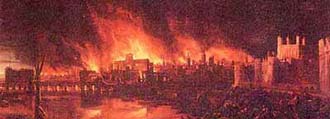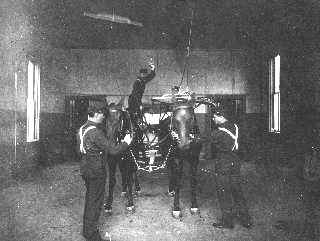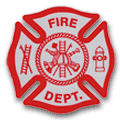Throughout history man has harnessed fire as an energy source, but man has also fought a war against fires destructive nature. To protect the population it was necessary to fight fires positively, so a firefighting force emerged and has evolved throughout the centuries into the modern fire service.
The first organized fire brigade was born during the rule of the Roman Empire. The first attempts to produce a firefighting force, using slaves all failed until a fire destroyed nearly a quarter of Rome during the reign of Emperor Augustus. After this disaster Emperor Augustus formed the first fire brigade called the ‘Corps of Vigiles’, however the fall of Rome marked the end of the ‘Corps of Vigiles’.
Britain got its first organized fire brigade in 43AD when the Romans invaded, after they left Britain’s first fire brigade disbanded.
In 1066 the Normans invaded Britain and introduced the first basic fire safety laws. However it wasn’t until September 1666 when the Great Fire of London destroyed 436 acres of London that it became apparent that an effective firefighting force was required.
After the Great Fire of London, fire insurance companies began to appear, but they soon discovered that large fires were bad for business and soon they began to establish their own fire brigades to improve profit margins.
At this point fire marks were introduced, people would fix these lead or copper insignia to the wall of their houses to show which insurance company they were with. When a fire broke out all the fire brigades would rush to the fire, if the house did not have their company’s fire mark they would stand back and wait for the rival company’s firefighters to turn up. If the house did not have a fire mark and there was more than one company on the scene, a fight often broke out as the competing companies tried to get the householder to sign up with their company.

A HISTORY OF FIREFIGHTERS IN AMERICA
The noble service of firefighting began in the early days of colonial America in Jamestown, Virginia. In January 1608, a fire spread through Jamestown, destroying much of the colonists' homes and provisions. Captain James Smith, who governed the colony at the time, reflected, "I begin to think that it is safer for me to dwell in the wild Indian country than in this stockade, where fools accidentally discharge their muskets and others burn down their homes at night."
As the colonists populated the New World, they often faced the threat of fires. In 1648, the colony of New Amsterdam (later New York) established practices that would become the first steps to organized firefighting in America. First, Governor Peter Stuyvesant appointed fire wardens over the city. These men were given authority to inspect all chimneys and impose fines on anyone who violated the rules of public safety. Later, the colony organized a volunteer force of men who patrolled the streets at night carrying large wooden rattles. If the men spotted a fire, they spun the rattles and then directed the formation of bucket brigades to put out the fire.
The city of Boston was also significant in the development of firefighting in America. When it suffered a series of arson fires and a large conflagration in 1676, the city decided that it needed more effective technology to fight fires. At that time, England was producing a "state of the art fire engine" or London pumper. They sent for this modern piece of machinery, and soon afterwards, America organized its first fire engine company. The company consisted of twelve men and a captain, and they were given wages for their service. The captain's name was Thomas Atkins, and he is remembered as the first firefighting officer in the country.
Fort Worth, TX 1890
The Nation’s first Fire Regulations and other Fire Protection Laws ---1627--- America’s first building code regulations were enacted in Plymouth, Massachusetts in 1627. Similar requirements and regulations were enacted in 1631 by Boston selectmen who decreed that house chimneys shall not be built of wood or roofs made with thatch. An ordinance, in Boston passed later, called for chimneys to be swept regularly to keep them free from dangerous wood tar. Fire wardens were appointed to inspect for adherence to these fire Regulations / ordinances and were empowered to impose fines on all offenders. Also enacted was the first arson statute in America where the punishment for arson was death. Shortly after the Boston fire of January 14, 1653, which left three dead and one third of the population homeless, Boston quickly adopted a comprehensive fire prevention law.
Another of Boston’s fire prevention laws stated that no ships were permitted to have fires while anchored at the city wharves. This law was enforced by water bailiffs. For the mutual protection of Boston from fire, a law provided for six long ladders, four strong iron hooks attached to chains and ropes to be hung outside the meeting house, and a cistern built for a source of water. Streets were patrolled by volunteers on fire watch (night watchmen) from evening (10:00 PM) until dawn (5:00AM). On the discovery of a fire, those on patrol would sound an alarm, secure the community’s firefighting tools at the fire scene, and direct those in the community in the disciplines required for the protection of property and for the successful suppression of the fire.
Fort Worth, TX 1907
Although remembered for his other achievements, the famous statesman and inventor Benjamin Franklin was also a fireman. He founded the Union Fire Company in Philadelphia in 1736. The company started with thirty volunteer firefighters, and soon became the standard for volunteer fire companies. He often wrote about the need for organized firefighting in his newspaper The Pennsylvania Gazette. In 1740, Franklin organized the "Philadelphia Contributorship," which was an early form of fire insurance. Other famous Americans who served as firefighters included George Washington, Thomas Jefferson, Samuel Adams, John Hancock, Paul Revere, Alexander Hamilton, John Jay, John Barry, Aaron Burr, Benedict Arnold, James Buchanan and Millard Fillmore. Women also served in this noble tradition. Some of the most prominent women firefighters include Molly Williams, a black slave who belonged to a New York merchant, Marina Betts and Lillie Hitchcock.



